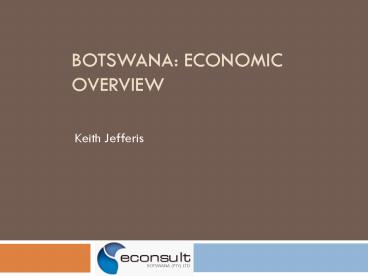Botswana: Economic Overview - PowerPoint PPT Presentation
1 / 24
Title:
Botswana: Economic Overview
Description:
Diversification must be export-led based on integration with the global economy ... New XR policy May 2005: change from fixed (but adjustable) to crawling peg ... – PowerPoint PPT presentation
Number of Views:158
Avg rating:3.0/5.0
Title: Botswana: Economic Overview
1
Botswana Economic Overview
- Keith Jefferis
2
Botswanas Growth Record
- Best-performing economy in Africa over 30 years
from 1970-2000 - Average economic growth rates over 10 - highest
in the world - Comparable with Asian Tiger economies
- Driven by growth of diamond mining and exports
3
Botswanas Growth Record
- Per capita income approx USD 6600 (2006)
- World Bank middle-income status
- Highest in mainland SSA
- Higher than SA, Brazil, Turkey, Malaysia, Russia
4
Impact of Mineral Revenues
- Minerals make up some 90 of total export
revenues - Basis of consistent balance of payments surpluses
- Accumulation of substantial foreign exchange
reserves - Basis for independent exchange rate policy
5
Impact of Mineral Revenues
- Diamond mining highly profitable - for both De
Beers and Botswana Government - Mineral revenues contribute 50 of total govt.
revenues - Basis for developmental state
- Wide-ranging government spending on social and
economic infrastructure (education, health,
roads, water etc.)
6
Current Issues - Diversification
- Economy is at a transition stage needs to
diversify - Diamonds remain very important, but period of
rapid diamond-led growth ending - Need to diversify sources of economic activity to
sustain future growth
7
Current Issues - Diversification
- Diamonds mining is capital intensive need for
employment generation to deal with unemployment
and poverty - Vulnerability to market changes reduce
dependence on single commodity - Diamond revenues will decline once mining goes
underground and deposits are eventually exhausted - Government budget new revenue sources needed
- New sources of export earnings
8
Projections of Diamond Revenues
Source IMF Botswana Selected Issues, 2007
9
Economic Structure (GDP, 2006/07)
10
GDP Growth
11
Diversification
- Diversification must be export-led based on
integration with the global economy - Initial focus on manufacturing limited success
- Broader range of activities now encouraged
- financial and business services
- tourism
- manufacturing
- new mining ventures
- Has been some progress in diversifying exports
12
Diversification Policy
- Policy framework aims to support investment
across range of activities - Conducive macroeconomic framework
- Enhance overall investment climate
- Improve competitiveness and productivity
- Boost institutional efficiency
- Key role for FDI
- Strengthen citizen participation empowerment
13
Macroeconomic Policies
- Basic Philosophy
- Liberal, market-based
- Development role for Government
- Consistent and stable
- Based on discussion and national consensus
- Key Policies
- Competitive exchange rate
- Fiscal balance sustainability
- Contain inflation
14
Exchange Rate Policy
- Policy objective
- stable real exchange rate
- to support trade, exports import substitution
- Pula pegged to a basket comprising ZAR and SDR
- Concerns about overvaluation and lack of
competitiveness between 2000 and 2004 - Hence devaluations in 2004 and 2005 (total
approx. 20)
15
Exchange Rate Policy
- New XR policy May 2005
- change from fixed (but adjustable) to crawling
peg - small changes to prevent misalignment
- more certainty (no more step devaluations)
- 11 further devaluation (against the basket)
since mid-2005 - Future exchange rate movements
- Long-term tendency for ZAR to depreciate against
USD, EUR etc - Pula likely to be stable vs rand (1.10 1.20)
and to depreciate with rand against major
currencies
16
Pula Exchange Rate vs Basket
- Overall rate stable on a day to day basis
- Devaluations and crawling peg clearly visible
17
Pula Exchange Rate vs ZAR, USD
- Currencies in basket float against each other
- Bilateral exchange rates driven by ZAR/USD and
ZAR/EUR rates
18
Monetary Policy
- Bank of Botswana runs independent monetary policy
setting interest rates - Aims to keep inflation comparable with trading
partners to preserve competitiveness - BoB targets a medium term inflation rate of 3-6
(same as SA)
19
Inflation and Interest Rates
- Inflation largely determined externally (import
prices) - Inflation spikes due to
- VAT (2002)
- Devaluation (2005)
- Rising oil and food prices (2008)
- Relatively high interest rates reflecting high
inflation
20
External Assessments
- Credit Ratings
- Moody's and SP have rated Botswana since 2001
- Investment grade sovereign ratings highest in
Africa - Moody's local currency rating A1
- same as Chile, Czech Rep, Greece, Estonia, Japan
- higher than Brazil, S. Korea, Malaysia, SA
Russia
21
External Assessments
- Credit rating positive assessments
- Very low public debt - domestic and foreign and
strong asset base - Long record of political and macroeconomic
stability - Strong balance of payments and government budget
- no domestic or external imbalances
22
External Assessments
- Credit rating negative assessments
- Narrow economic base
- Slow diversification
- HIV/AIDS fiscal, social and economic impact
- Poverty levels
23
External Assessments
- World Economic Forum Global Competitiveness Index
- Botswana rated no.3 in sub-Saharan Africa (after
SA and Mauritius) - Fraser Institute and Heritage Foundation
- High degree of economic freedom (top in Africa)
- World Bank Survey of Doing Business
- Botswana rated 51 globally (out of 155 countries)
- IMF
- generally positive annual assessments no
borrowing
24
Thank You
Email info_at_econsult.co.bwwww.econsult.co.bw































